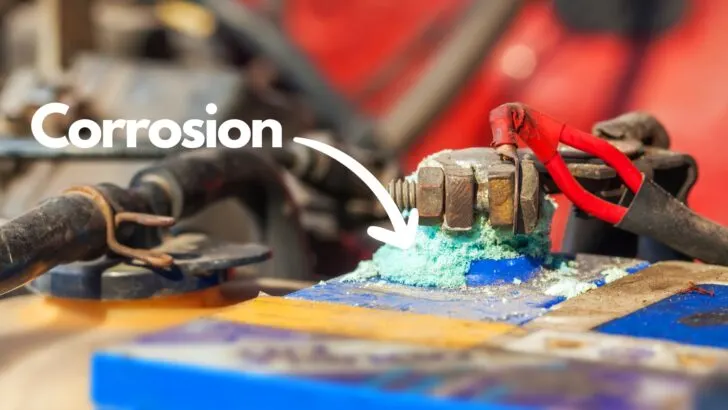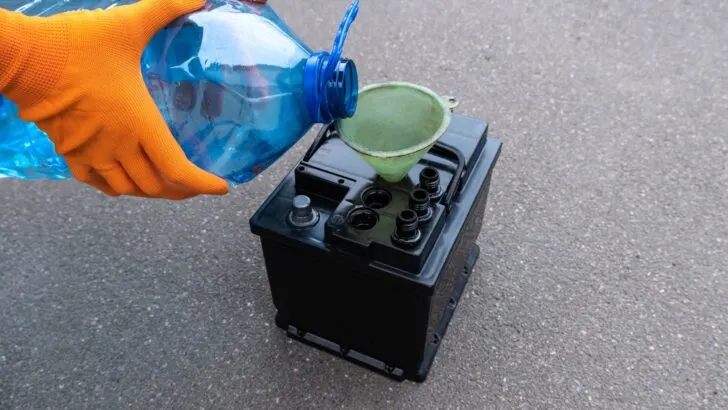We’ve posted before about how to clean battery terminals as part of regular RV battery maintenance. But what causes RV battery corrosion in the first place, and how can you prevent it?
If your RV has flooded lead-acid batteries, you want to do whatever you can to avoid the buildup of corrosion.
Properly maintained flooded cell batteries can last for 5-6 years. But unless you take steps to maintain them well (and consistently), they’re prone to developing several issues that will likely lead to an early demise, sometimes in as little as a year or two.
Among those issues is battery corrosion. RV battery terminal corrosion not only reduces conductivity, which decreases a battery’s performance and efficiency but also leads to an early death.
RV batteries are too expensive to ignore. So let’s look at what causes corrosion on battery terminals (as well as RV battery compartment corrosion) and the steps you can take to prevent it from happening.
What Is RV Battery Corrosion?
The clamps at the ends of your battery cables are generally made of copper. When gases leak from a flooded lead-acid battery and mix with the current coming through the clamps, a chemical reaction produces copper sulfate, a pale green-colored compound.

This is what RV battery terminal corrosion looks like. It’s the pale green substance surrounding the exposed motel battery terminal.
When you find corrosion on your battery terminals, wires, or clamps, what you see is that compound: hydrated copper sulfate.
What Causes RV Battery Corrosion?
First, let’s be clear that when we talk about battery corrosion issues, we’re talking about flooded lead-acid batteries.
As we discussed at length in our RV battery guide, four different types of batteries are commonly used in RVs, and they use different types of battery chemistries.
So, while flooded lead-acid batteries tend to form corrosion, the alternatives of AGM, gel mat, and lithium batteries don’t have this issue due to their design. (This is also why these other types of batteries are essentially maintenance-free.)
Flooded lead-acid batteries are, by far, the most susceptible to corrosion. That’s because hydrogen gas is released as your battery charges and discharges. Flooded lead acid batteries need venting ports to prevent the risk of the battery exploding from the buildup of this gas. But as the hydrogen gas bubbles leave the venting ports of the battery, they can carry battery acid with them, which causes corrosion.
Let’s take a look at the most common causes of battery terminal corrosion.
Age/Battery Sulfation
Batteries create electricity through a chemical reaction. Sulfuric acid in the liquid electrolyte reacts with the lead on the plates, forming lead sulfate.
Charging a battery reverses that chemical process, converting the lead sulfate back to metallic lead (on the plates) and sulfuric acid (in the electrolyte).
As batteries age, more and more of the lead sulfate remains on the plates, causing the battery to bubble more and for longer when it’s charging. That bubbling (often called “boiling”) leads to more acidic vapor being able to escape the vents on the battery caps.
Eventually, there’s enough present for it to cause corrosion on any exposed metal in the battery compartment.
Overfilled Batteries
The out-gassing noted above causes fluid loss from the cells of a flooded lead-acid battery. But these batteries require that fluid to function properly.
This is why you need to periodically check the cells to ensure the electrolyte fluid (a sulfuric acid solution) is at the proper level. If the fluid level of a cell is low, it needs to be replenished with distilled/deionized water.

Always use distilled water when filling the cells of a flooded lead-acid battery, and be sure not to overfill the cells. Wear gloves and eye protection whenever you’re working with batteries.
However, overfilling a battery’s cells causes issues, too. If you overfill a cell, the excess water can lead to more acid vapor escaping during charging, causing more corrosion.
The correct level for the fluid in a flooded lead-acid battery is just touching the bottom of the fill port. If the level is below that, fully charge them and then add only enough distilled water so the electrolyte level in the battery just reaches the bottom of the tube. Never fill them any higher than that.
While it’s important never to overfill the batteries, it’s equally important never to allow the fluid level to drop to the point where the metal battery plates are exposed (which can damage them and shorten your battery life).
Leaking Due to Damaged Vent Caps or Battery Casing
As we discussed above, flooded lead acid batteries require a venting system. This is also the main reason flooded lead-acid batteries need to be stored in well-ventilated areas – so that hydrogen gas (extremely explosive!) doesn’t build up.
However, cracks or flaws in one or more of the battery’s vent caps can allow too much acid vapor to escape (outgas) during charging.

While these are extreme examples, any damage to battery caps, terminals, wires, or the battery casing itself can lead to excessive out-gassing.
If fluid leaks out due to a damaged battery casing, the fluid (electrolyte) will cause corrosion.
Left unchecked, leaking fluid will leave you with a non-functioning battery.
Faulty or Misconfigured Charger or Converter/Charger
Lead acid batteries perform best and last the longest when they are properly charged.
But if your charger or converter/charger is either misconfigured (for example, the wrong battery type has been selected) or is failing, it could be supplying the wrong voltage during charging. This is especially likely with older RV battery chargers/converters that only use a single or dual-stage charging cycle.
Overcharging is commonly understood to be a problem, but undercharging can be just as bad or worse. This is because undercharging increases the formation of lead sulfate on the lead battery plates, which leads to over-boiling during normal charging.
How to Prevent or Reduce RV Battery Corrosion
There are a number of ways to prevent or greatly reduce the development of corrosion on a flooded lead-acid battery, giving your battery improved performance and a better chance at a long life before needing to be replaced.
Regular Inspection
This is one of the most important things to do to prevent corrosion from building up on your positive and negative terminals and throughout the battery compartment.
Regular inspection and battery cleaning are a great way to ensure that the corrosion never gets out of hand.
As we note in far more detail in our post on how to clean battery terminals, you can use a small wire brush like the ones below. If you have very extensive corrosion throughout the battery compartment, you’ll want to remove the battery and clean everything thoroughly.
Remember – a flooded lead-acid battery contains sulfuric acid, a substance that can cause serious burns on the skin and serious injury to the eyes. When working with a battery, always wear gloves and skin & eye protection.
- Three different types: The pack includes a brass, nylon and metal brush. Suitable for different surface types, they will address all your cleaning...
- Multiple uses: All our brushes serve different purposes! You can use the stainless steel wire brush for rust removal, while the nylon brush is perfect...
Use Water Miser Battery Caps
Replace your battery caps with special ones that are designed to help reduce the escape of battery acid droplets/vapor. Water Miser battery caps are a popular option for this purpose.
- Reduce Watering and Corrosive Acid build up on your batteries
- Fits 95% of all US and Foreign Lead Acid Batteries
Use a Battery Terminal Protectant
Treat your RV’s battery terminals with a protective coating. Spray-on protectants like this one are designed to protect battery terminals from corrosion and can be used on battery posts, terminals, hold-downs, and casings.
- Specially designed to protect battery terminals from corrosion, a leading cause of hard starting and battery failure.
- Provides a lead-free soft protective coating
Use Dielectric Grease
Dielectric grease protects electrical connections and wiring from salt, dirt, and corrosion, so it’s a great alternative to the battery terminal protectant spray listed above.
You want to use caution applying the grease. Once you’ve cleaned the terminals and posts well, you’ll coat both parts of the terminal contact with the Dielectric Grease and reconnect your battery cables.
- Protects electrical connections and wiring from salt, dirt and corrosion
- Prevents voltage leaks around any electrical connection
Add Thermoil Liquid
Thermoil liquid forms a protective barrier on the top of the battery cell’s liquid electrolyte to stop acid vapor from escaping. This reduces both water loss and corrosion.
You simply add a liquid like Battery De-Mister to your flooded lead acid batteries, and the oil forms a thin layer on the surface that helps stop acid from escaping during the charging process.
- Maximize battery lifespan: The Thermoil battery protector liquid is engineered with ThermOil technology to significantly extend the life of your...
- Efficient performance enhancement: The unique formulation of our battery corrosion preventative liquid reduces toxic fumes emitted during charging,...
Check/Replace Your RV Battery Charger or Converter/Charger
Checking your battery charger or converter/charger to make sure it’s properly set up and working to charge your batteries properly is an important part of RV battery maintenance.
If your converter/charger is an old model that doesn’t offer 3-stage charging (including float charging), you may need to replace it so that you’re not constantly overcharging or undercharging your batteries.
Install Anti-Corrosion Felt Washers
This is a very inexpensive way to prevent or reduce corrosion from forming on your battery terminals and posts. Felt washers absorb the condensed acid vapor and contain anti-corrosion additives that help prevent it from reacting with the terminals and leading to a badly-corroded battery.
- Package: 24 pieces battery terminal anti corrosion washers include 12 red and 12 green, enough quantity for your use and replacement.
- Color: the color coded for positive and negative terminals, red for +, green for -, easy to distinguish and use.
With proper maintenance and regular attention, your RV batteries can last for several years instead of needing to be replaced every year or two.
Free RVing Tips, Tricks, Reviews, Giveaways & More
Subscribe to our daily newsletter! We’ve been full-time RVers for 20 years (!) and share everything we’ve learned about RVing in our daily blog posts. Join our online community to receive a wealth of great RVing knowledge delivered right to your inbox.
Whether this is your first time on the road or you’re a seasoned full-timer, you’ll love the wide range of RVing topics we cover. Don’t miss a single article or any of our famous RV gear Giveaways — Subscribe today!








Paul Cooper
Saturday 1st of July 2023
I have a question. I have a couple of constant duty solenoids to isolate my battery banks. I noticed that they get quite hot when in use (ignition on). Not so hot that they would burn my fingers but hot enough that I can't hold them. Is this normal?
Paul Cooper
Saturday 1st of July 2023
@RVgeeks, thanks for the info
Paul Cooper
Saturday 1st of July 2023
@TheRVgeeks, After 10-15 minutes they get to about 120F or more. No load on.
TheRVgeeks
Saturday 1st of July 2023
Hi Paul. It's usually perfectly normal for a continuous-duty solenoid like that to get quite hot... usually after about an hour or so of the ignition being on.
sparky1
Saturday 17th of June 2023
Great articles thanks